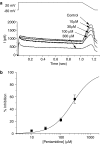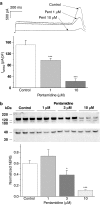Pentamidine reduces hERG expression to prolong the QT interval
- PMID: 15711592
- PMCID: PMC1576113
- DOI: 10.1038/sj.bjp.0706140
Pentamidine reduces hERG expression to prolong the QT interval
Abstract
Pentamidine, an antiprotozoal agent, has been traditionally known to cause QT prolongation and arrhythmias; however, its ionic mechanism has not been illustrated. In a stable HEK-293 cell line, we observed a concentration-dependent inhibition of the hERG current with an IC50 of 252 microM. In freshly isolated guinea-pig ventricular myocytes, pentamidine showed no effect on the L-type calcium current at concentrations up to 300 microM, with a slight prolongation of the action potential duration at this concentration. Since the effective concentrations of pentamidine on the hERG channel and APD were much higher than clinically relevant exposures (approximately 1 microM free or lower), we speculated that this drug might not prolong the QT interval through direct inhibition of I(Kr) channel. We therefore incubated hERG-HEK cells in 1 and 10 microM pentamidine-containing media (supplemented with 10% serum) for 48 h, and examined the hERG current densities in the vehicle control and pentamidine-treated cells. In all, 36 and 85% reductions of the current densities were caused by 1- and 10-microM pentamidine treatment (P<0.001 vs control), respectively. A similar level of reduction of the hERG polypeptides and a reduced intensity of the hERG protein on the surface membrane in treated cells were observed by Western blot analysis and laser-scanning confocal microscopy, respectively. Taken together, our data imply that chronic administration of pentamidine at clinically relevant exposure reduces the membrane expression of the hERG channel, which may most likely be the major mechanism of QT prolongation and torsade de pointes reported in man.
Figures






Comment in
-
Protein trafficking abnormalities: a new mechanism in drug-induced long QT syndrome.Br J Pharmacol. 2005 May;145(1):3-4. doi: 10.1038/sj.bjp.0706143. Br J Pharmacol. 2005. PMID: 15711590 Free PMC article.
References
-
- BAILLY C., DONKOR I.O., GENTLE D., THORNALLEY M., WARING M.J. Sequence-selective binding to DNA of cis- and trans-butamidine analogues of the anti-Pneumocystis carinii pneumonia drug pentamidine. Mol. Pharmacol. 1994;46:313–322. - PubMed
-
- BIBLER M.R., CHOU T.C., TOLTZIS R.J., WADE P.A. Recurrent ventricular tachycardia due to pentamidine-induced cardiotoxicity. Chest. 1988;94:1303–1306. - PubMed
-
- CARDOSO J.S., MOTA-MIRANDA A., CONDE C., MOURA B., ROCHA-GONCALVES F., LECOUR H. Inhalatory pentamidine therapy and the duration of the QT interval in HIV-infected patients. Int. J. Cardiol. 1997;59:285–289. - PubMed
-
- CONTE J.E., JR, UPTON R.A., PHELPS R.T., WOFSY C.B., ZURLINDEN E., LIN E.T. Use of a specific and sensitive assay to determine pentamidine pharmacokinetics in patients with AIDS. J. Infect. Dis. 1986;154:923–929. - PubMed
-
- CORTESE L.M., GASSER R.A., JR, BJORNSON D.C., DACEY M.J., OSTER C.N. Prolonged recurrence of pentamidine-induced torsades de pointes. Ann. Pharmacother. 1992;26:1365–1369. - PubMed
MeSH terms
Substances
LinkOut - more resources
Full Text Sources
Miscellaneous

